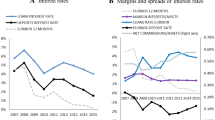Abstract
This paper investigates the impact of bank market structure differences within U.S. states on entrepreneurial activity. A panel model is used to evaluate differences in new firm starts within the states relative to the bank market structure and competition. The results indicate that states with more small banks, as measured by the number of unit banks, and banks with more branch locations contribute to new firm creation. Overall competition, as measured by the total number of banking institutions, has a negative effect on firm creation. There is limited evidence that bank failures also have a negative impact on firm creation within the state.
Similar content being viewed by others
References
Acs, Z. J., Arenius, P., Hay, M., & Minniti, M. (2005). Global entrepreneurship monitor 2004 executive report. Babson Park, MA: Babson College.
Armington, C. (1998). Statistics of U.S. businesses—microdata and tables. Data on establishments by firm size. SBA/Census p. 6.
Bates, T. (1990). Entrepreneur human capital inputs and small business longevity. The Review of Economics and Statistics, 72(4), 551.
Black, S., & Strahan, P. (2002). Entrepreneurship and bank credit availability. Journal of Finance, 57(6), 2807–2833.
Blanchflower, D., Oswald, A., & Stutzer, A. (2001). Latent entrepreneurship across nations. European Economic Review, 45(4–6), 680–691.
Boot, A., & Thakor, A. V. (2000). Can relationship banking survive competition? Journal of Finance, 55, 679–714.
Breit, E., & Arano, K. (2009). Reduction of information asymmetries in small business lending: Evidence from the survey of small business finances (SSBF). Journal of Financial and Economic Practice, (Fall 2009), 71–85.
Campbell, N. D., & Rogers, T. (2007a). Economic freedom and net business formation. Cato Journal, 27(1), 23–36.
Campbell, N. D., & Rogers, T. M. (2007b). State fiscal policy and small business creation. Journal of Private Enterprise, 22(2), 119–136.
Colombo, M., & Grilli, L. (2005). Founders’ human capital and the growth of new technology-based firms: A competence-based view. Research Policy, 34(6), 795–816.
Gohmann, S., Hobbs, B. K., & McCrickard, M. J. (2008). Economic freedom and service industry growth in the United States. Entrepreneurship Theory and Practice, 32(5), 855–874.
Hall, C., & Sobel, R. S. (2006). Institutions, entrepreneurship, and regional differences in economic growth. Southern Journal of Entrepreneurship, 1(1), 69–96.
Hein, S. E., Koch, T. W., & MacDonald, S. S. (2005). On the uniqueness of community banks. Economic Review—Federal Reserve Bank of Atlanta, 90(1), 15–36.
Henley, A. (2005). Job creation by the self-employed: The roles of entrepreneurial and financial capital. Small Business Economics, 25(2), 175.
Ho, Y. P., & Wong, P. K. (2007). Financing, regulatory costs and entrepreneurial propensity. Small Business Economics, 28(2–3), 187.
Holtz-Eakin, D., Joulfaian, D., & Rosen, H. S. (1994a). Sticking it out: Entrepreneurial survival and liquidity constraints. The Journal of Political Economy, 102(1), 53.
Holtz-Eakin, D., Joulfaian, D., & Rosen, H. S. (1994b). Entrepreneurial decisions and liquidity constraints. RAND Journal of Economics, 25(2), 334–347.
Huyghebaert, N., Van De Gucht, L., & Van Hulle, C. (2007). The choice between bank debt and trace credit in business start-ups. Small Business Economics, 29(4), 435–452.
Johnson, P., & Parker, S. (1994). The interrelationships between births and deaths. Small Business Economics, 6(4), 283–291.
Johnson, P., & Parker, S. (1996). Spatial variations in the determinants and effects of firm births and deaths. Regional Studies, 30(7), 679–689.
Karabegovic, A., Samida, D., Schlegel, C., & McMahon, F. (2003). North American economic freedom: An index of 10 Canadian provinces and 50 U.S. states. European Journal of Political Economy, 19(3), 431–452.
Kreft, S. F., & Sobel, R. S. (2005). Public policy, entrepreneurship, and economic growth. Cato Journal, 25(3), 595–616.
Madsen, H., Neergaard, H., & Ulhoi, J. P. (2003). Knowledge-intensive entrepreneurship and human capital. Journal of Small Business and Enterprise Development, 10(4), 426–434.
Petersen, M. A., & Rajan, R. G. (1995). The effect of credit market competition on lending relationships. Quarterly Journal of Economics, 110, 407–443.
Reynolds, P. D., Carter, N. M., Gartner, W. B., & Greene, P. G. (2004). The prevalence of nascent entrepreneurs in the United States: Evidence from the panel study of entrepreneurial dynamics. Small Business Economics, 23(4), 263–284.
Robb, A. M. (2002). Entrepreneurial performance by women and minorities: The case of new firms. Journal of Developmental Entrepreneurship, 7(4), 383–397.
Roper, S., & Scott, J. (2009). Perceived financial barriers and the start-up decision: An econometric analysis of gender differences using GEM data. International Small Business Journal, 27(2), 149.
Scott, A. (2004). Small business and the value of community financial institutions. Journal of Financial Services Research, 25(2/3), 207–230.
Shane, S. (1996). Explaining variation in rates of entrepreneurship in the United States: 1899–1988. Journal of Management, 22(5), 747–781.
Singh, G., & DeNoble, A. (2003). Early retirees as the next generation of entrepreneurs. Entrepreneurship Theory and Practice, 27(3), 207–226.
Small Business Administration (SBA), Office of Advocacy (2009). Frequently asked questions. Available at: http://www.sba.gov/advo/stats/sbfaq.pdf.
Sobel, R. S. (2008). Testing Baumol: Institutional quality and the productivity of entrepreneurship. Journal of Business Venturing, 23(6), 641–655.
Sullivan, D. M. (2007). Minority entrepreneurs: More likely to try, but less likely to succeed? The Academy of Management Perspectives, 21(1), 78–79.
Weber, P., & Schaper, M. (2004). Understanding the grey entrepreneur. Journal of Enterprising Culture, 12(2), 147–164.
Author information
Authors and Affiliations
Corresponding author
Rights and permissions
About this article
Cite this article
Rogers, T.M. Bank market structure and entrepreneurship. Small Bus Econ 39, 909–920 (2012). https://doi.org/10.1007/s11187-011-9320-0
Accepted:
Published:
Issue Date:
DOI: https://doi.org/10.1007/s11187-011-9320-0




